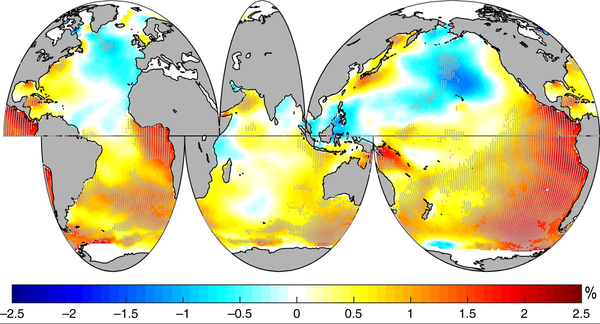Increasing wave power
Image of the Month - July 2019

Ocean waves are affecting navigation, coastal infrastructure, etc. Determining the global trends affecting waves is thus important. Global wave power is the transport of the energy transferred from the wind into sea-surface motion. It takes into account both the wave heights and periods and can thus characterize the long-term behavior of the global wave conditions. Satellite-based altimeter measurements from 1985 to 2008 reveal increases of 0.25% per year for the 90th wave height percentile and 0.50% per year for the 99th percentile, in both hemispheres, i.e. that increases have been larger for the extreme values as compared to the mean condition. Wave periods have also increased and direction of waves shifted, for example in the Southern Ocean and in the North Atlantic.
A study is showing that this wave power, computed combining significant wave heights from satellite altimetry and model results (validated with buoy measurements) has increased globally (by 2.3% per year since 1994) and by ocean basins. Using historical models and recontruction, it is estimated that the increase was 0.4% per year on average since 1948. This increase has been occurring in association with the upper-ocean warming, a consequence of anthropogenic global warming, which is changing the global wave climate, making waves stronger.
Satellite altimetry have been measuring continuously sea surface height, but also wave and winds from more than 25 years now, with previous satellites also providing such data. Jason-CS/Sentinel-6 and the constellation of the Sentinel-3 will or are continuing this monitoring into the next decade. Moreover, CFOSat, which data will be soon publicly available, is able to measure both wave heights and periods.
See also:
- Applications: Wind and Waves
- Image of the Month, June 2011: Extreme wave heights
- Image of the Month, September 2003: Scaling the waves
- Image of the Month, December 1999: Measuring waves... with waves
- Missions: CFOSat
- Data: Wind/waves products
References:
- Borja G. Reguero, Iñigo J. Losada & Fernando J. Méndez , A recent increase in global wave power as a consequence of oceanic warming, Nature Communications, volume 10, 205 (2019) https://doi.org/10.1038/s41467-018-08066-0




